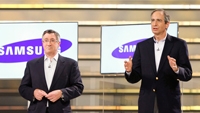Internet-connected TVs build momentum at CES

Ready or not, the Internet-connected TV set has emerged as the next big thing in consumer electronics after 3-D TVs failed to capture mainstream consumers’ attention to any large degree. At the 2011 International CES, the marriage of TV and the Internet was a key message as industry giants Samsung, Sony, LG and Panasonic, as well as smaller players such as Vizio, all highlighted the latest versions of their connected TVs.
The research firm Parks Associates expects connectable models to make up 76 percent of global TV sales by 2015. This is despite concerns about whether the current broadband infrastructure can cope with such a massive boost in simultaneous online usage.
The most apparent use to home viewers may be as a simpler way to access sports, movies and standard TV content. The sets substitute the cable, satellite or game consoles that many households now resort to for streaming video.
Sony and Samsung announced content deals with Time Warner Cable at CES, and Samsung made public a deal with Comcast. These alliances may be influenced by the cable companies’ need to protect their customer base against growing threats from the Web, where viewers watch many programs for free.
Executives from Time Warner Cable and Comcast joined Boo-Keun Yoon, Samsung’s president and general manager of visual displays, on stage during his CES keynote. They discussed plans to bring live programming to Samsung’s Internet-connected TV and tablets without the need for a set-top box.
Glenn Britt, CEO of Time Warner Cable, said his company would allow customers to access its full lineup of live channels on Samsung Internet-connected TVs this year.
“If you buy a video subscription from us in your home, our goal is to make the video available on all your devices,” Britt said, echoing the goal of the “TV everywhere” concept espoused by his and other companies. “People don’t see PCs and phones and tablets and TVs as different things; they are all just video display devices.”
The professional video industry's #1 source for news, trends and product and tech information. Sign up below.
Comcast will do the same. “We’re radically changing the way our customers interact with their televisions,” said Brian Roberts, CEO of Comcast.
One of the interesting aspects of the TV-Internet phenomenon is that it’s so unpredictable. It can go anywhere, despite corporate attempts to define the trend.
“What makers are realizing is that there’s no way to predict what the next phenomenon will be, so it’s best to open it up to third parties,” said Kurt Scherf, a principal analyst at Parks Associates.
Samsung, LG and Panasonic are all set to offer third-party applications on their television sets, similar to one used on smart phones and tablets.
With so many electronics makers vying to differentiate themselves, none has yet come out as a clear leader, and several are finding it difficult to make profits from TVs at all.
What is still lacking, in large part, is consumer education about Internet-connected TVs. Sony’s chief executive, Howard Stringer, said last week that Sony would start a worldwide advertising campaign called “Television Redefined” this year.
“The next evolution is upon us: the marriage of the television and the Internet,” he said.
